Comparison of 5 headsets for meditation:
NeuroSky MindWave Mobile, Muse, EMOTIV EPOC+, EMOTIV Insight and Melomind
This article is about comparison of 5 probably best headsets for meditation. General questions of EEG meditation and various applications for PC are described in this article.
|
1. Software for meditation |
2. The comfort of wearing |
3. The overall comfort of use for meditation |
4. Reliability of data |
5. Price |
6. Total |
| NeuroSky MindWave Mobile |
A lot of available |
10/10 in version 'MindWave Mobile 2' |
10/10. You can start meditate and get biofeedback just in a few seconds. The best "meditation" parameter. |
10/10 with clean sensors and skin. It is better to clean the sensors after 2-3 meditation sessions. |
100$ |
10/10 |
| Muse |
A few |
9/10 |
8/10. You can start meditate after a minute of tuning of the sensors and lection, and get results only after a few minutes meditation session with available software.* |
7/10 with clean sensors and skin. Scientific studies 1 2 show low reliability and weak noise immunity of EEG data. The "Calm" parameter plays along with the user in every possible way to form a positive impression of the headset. Although there are 7 sensors against 3 of NeuroSky, you still need to clean it after 2-3 sessions. |
250$ |
7/10* |
| A detailed comparison of NeuroSky MindWave Mobile 2 and Muse 1 (Model MU-02, 2016) neuro headsets in context of meditation practice. |
| EMOTIV EPOC+ |
A few* |
5/10 |
1/10. "Wet" sensors. |
May be 8-10/10. |
799$ |
2/10* |
| EMOTIV Insight |
A few* |
7/10 |
5/10. The rear sensor often lags behind the skin and loses signal. |
May be 9/10. |
299$ |
5/10* |
| Melomind |
A few* |
9/10 |
No data available. But it seems more like musical relaxation device.* |
No data available. Supposed to be 10/10 regardless of the regular cleaning of the sensors. |
400$ |
6/10* |
| * Until suitable software will be available specifically for meditation. |
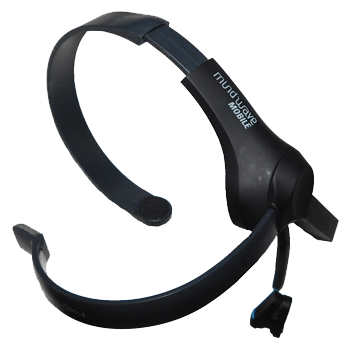 The NeuroSky MindWave Mobile headset is available since 2011, and at the end of 2016 an improved "MindWave Mobile+" version was released. In May 2018, a new, very wearable version "MindWave Mobile 2" was released. This is the first mass gadget to read the EEG, and at the moment, sold more than 4 million sets, which makes this headset also the absolute leader in sales among all varieties of similar (EEG) devices, including for meditation. In addition, the company also sells the "base" of the headset – the TGAM module, which provides EEG reading and its transfer via the COM port, which is used in a variety of projects.
The NeuroSky MindWave Mobile headset is available since 2011, and at the end of 2016 an improved "MindWave Mobile+" version was released. In May 2018, a new, very wearable version "MindWave Mobile 2" was released. This is the first mass gadget to read the EEG, and at the moment, sold more than 4 million sets, which makes this headset also the absolute leader in sales among all varieties of similar (EEG) devices, including for meditation. In addition, the company also sells the "base" of the headset – the TGAM module, which provides EEG reading and its transfer via the COM port, which is used in a variety of projects.
1. Given the already 7-year presence of the headset on the market, as well as its dominance over other types of headsets, it is not surprising that there is a wide range of applications for it, including for meditation. For the meditators, “NeuroExperimenter” applications for PC, “EEG meditation” for Android, and the “Brainwave Visualizer” application with its “Float” game, available for PC, Android and iOS, may be of interest. A free SDK is available for writing your own applications.
2. When putting the headset on the head, the upper plastic adjustable headband, which performs only the mechanical function of fixing the headset on the head, can spoil the magnificent hairdress, if any. On the other hand, any headphones with an upper headband also press the hairdress to the scalp. Some argue that the headset is uncomfortable, and they get the headache after half an hour of wearing it. The author of this article did not experience that, and can also advise you to find a comfortable position of the headset on your head and try to maximally pull the upper adjustable headband.
3. This headset provides a possibility to start meditation with biofeedback in just a few (about 5) seconds after turning it on. At the same time there are applications for any "taste" – both with immediate biofeedback, and with a delay (the game Float). You do not need to wait for the headset to determine for one-and-a-half minutes what of the 7 sensors are now more or less clean, and then also listen to a minute of a lecture on meditation, as in the case of Muse. The only possible disadvantage – the headset can be inconvenient for long-term wearing by some people.
4. In spite of the fact that the center of alpha-wave generation in the head is closest to occipital region, with clean surfaces of sensors and skin at the points of contact, this EEG can be trusted by 90% or more. In fact, this is a full-fledged single-channel electroencephalograph. As with most such devices, it is recommended to wipe the skin surface at the points of contact with medical nonwoven alcohol disinfection cotton pad for injection almost every time before using the headset, as well as periodically the metal contacts of the headset sensors, especially the one for forehead.
5. This is the cheapest ($100) headset from the number of fully ready to use (not semi-finished products). Now the company is promoting a new BrainLink Pro headset for $200 with the same TGAM module, but in a form reminiscent of Muse and with a lithium battery.
6. As of 2018, the headset still remains the actual leader among such devices. Cheapness, a lot of different applications and the ability to use a headset for meditation just in a few seconds after it's turned on – these are all pluses of the NeuroSky MindWave Mobile gadget.
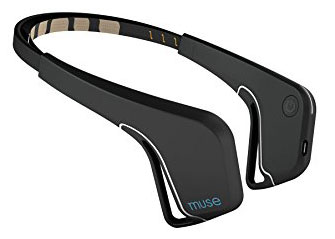 The Muse headset appeared in May 2014. The main differences from the NeuroSky headset are the lack of an upper headband, the presence of a built-in lithium battery and 7 sensors (5 on the forehead and 2 on the head skin behind the ears) instead of 3 of NeuroSky. In fact, Muse looks like an attempt to improve the first mass similar headset (NeuroSky).
The Muse headset appeared in May 2014. The main differences from the NeuroSky headset are the lack of an upper headband, the presence of a built-in lithium battery and 7 sensors (5 on the forehead and 2 on the head skin behind the ears) instead of 3 of NeuroSky. In fact, Muse looks like an attempt to improve the first mass similar headset (NeuroSky).
1. The number of applications is very limited. The basic application for meditation has its drawbacks (see subsection 3). An SDK is available for writing your own applications, which is free only if you write free applications.
2. Despite the absence of the upper headband (this is a "+"), some people say about the inconvenience of wearing a headset, because to ensure a quality signal it still needs to be pressed hard enough to the head. According to some people, this can cause a headache with prolonged wearing.
3. The basic application for meditation at the beginning spends a minute for calibration with voice prompts (and then one more minute could be spent for a lecture on meditation) before proceeding to actually reading the EEG. The application suggests pre-setting the duration of the meditation session in minutes (which also limits the user's ability). Biofeedback is limited in these minutes of meditation, the application also shows the final values and a graph after the end of the meditation session. Headset helps you to know your ability to meditate, and also allows you to improve your meditation by real-time biofeedback, although it is somewhat limited in its capabilities.
4. In spite of the fact that the center of alpha-wave generation in the head is closest to occipital region, with clean surfaces of sensors and skin at the points of contact, data of 4 EEG channels can be trusted by 90% or more. As with most of these devices, it is recommended to wipe the skin surface at the points of contact with medical nonwoven alcohol disinfection cotton pad for injection almost every time before using the headset, as well as periodically the metal contacts of the headset sensors also. Otherwise, especially in a hot climate, EEG data may not be reliable enough, despite the large number of sensors, since they still get contaminated all at the same time.
5. The average price is $250, which is much larger than one of the most common similar gadget.
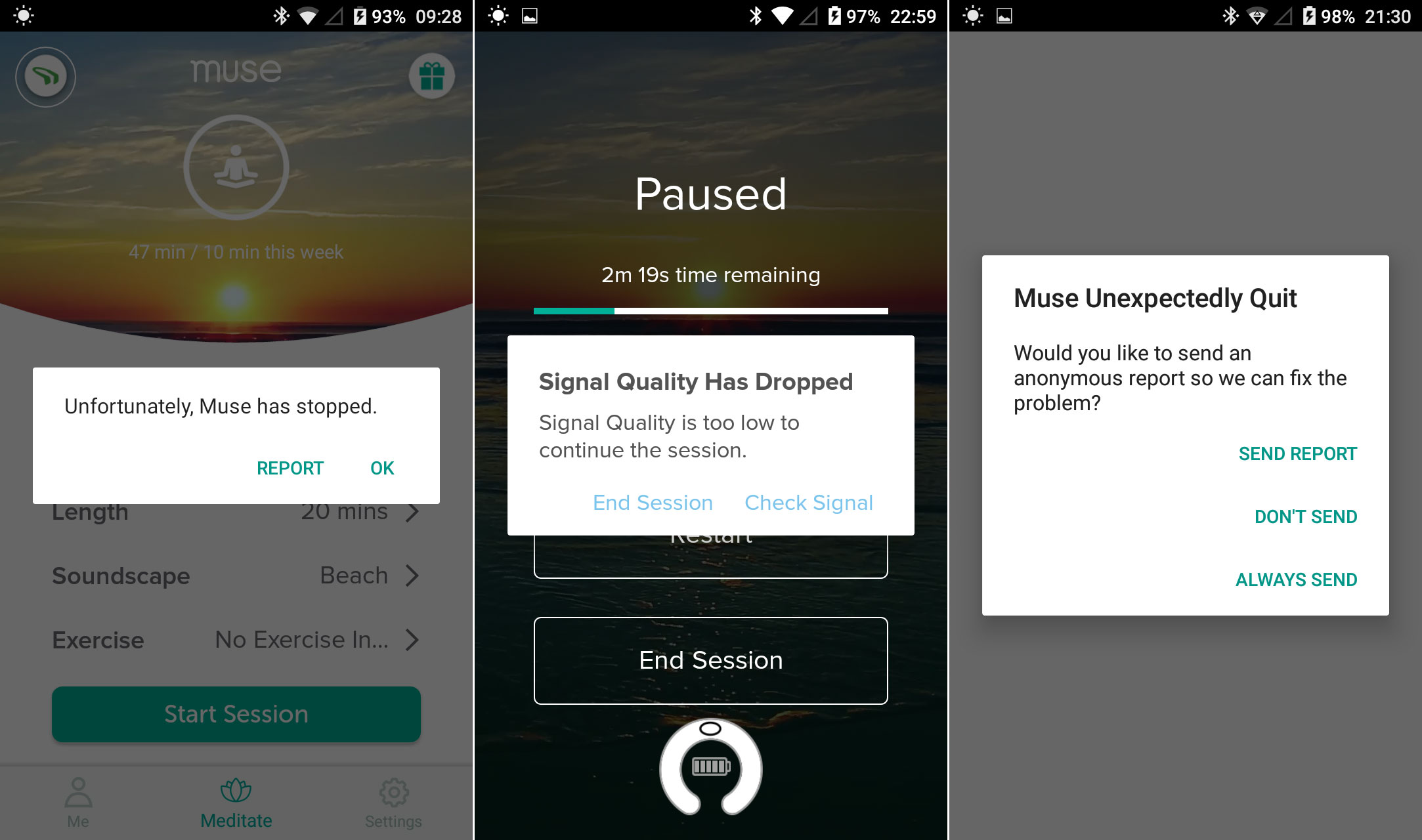 |
| Errors with Muse headset and app |
6. In general, this is a good attempt to create competition in the market for such devices. The only thing I would like to see for this device is convenient applications for meditation. May be one-and-a-half minutes of technical delay will not allow to write an application that allows you to immediately start a session of meditation with biofeedback in real time.
Many people believe that Muse is better than NeuroSky due to the fact that Muse has four EEG channels versus one in NeuroSky. But it is better to have one reliable channel with reliable data than four channels with data of questionable quality. The scientific study below analyzes not the quality of determining the state of shamatha meditation, but the quality of the basic EEG reading, in which NeuroSky corresponds to professional electroencephalographs, and Muse does not. Thus, the Muse headset is worse than the NeuroSky headset not only in determining the user's shamatha meditation state, but even in the quality of the initial EEG reading, which indicates the unreliability of the Muse headset EEG data.
What is especially bad for meditators using Muse is that shamatha meditation is characterized by the dominance of the alpha rhythm, which the Muse headset may sometimes not notice even at the level of reading a raw EEG and determining the values of brain rhythms, which, naturally, will affect poor definition of the presence of the state of shamatha meditation, see below the description for the second picture about the peaks of the alpha rhythm.
So far, we can say that almost the only thing where Muse is better than NeuroSky is its glamorous appearance.
Here is article about a scientific comparison of four medical and consumer wireless EEG systems for use in clinical trials – two professional medical systems (electroencephalographs) B-Alert X24 and Enobio 20, as well as two consumer – NeuroSky MindWave Mobile and Muse.
Fp1 channel power spectral densities (PSDs) comparison
Average PSDs in the Fp1 channel common to all the four EEG systems for Visit 1 and Visit 2 were calculated and were plotted for both EO (Figures A,B) and EC (Figures C,D) conditions. In the EO condition, B-alert and Enobio spectra were approximately equal, while Mindwave was slightly increased but followed a similar curve. A broadband increase in power was observed for PSDs acquired with the Muse system. Similarly, in the EC condition (Figures C,D), B-Alert, Enobio, and Mindwave PSDs were similar however increased broadband power was observed for Muse spectra, which also appeared to have higher variation than the other systems. Peaks at 8–12 Hz (alpha band) were visible in the spectra acquired with the B-Alert, Enobio, and Mindwave systems at each visit. While there was a clear alpha peak for the Muse power spectra on Visit 2, no peak was observed in the Visit 1 spectra.
Fp1 channel resting EEG test/retest comparison
In the EC condition, the power spectral ratio was between 0.975 and 1.025 for B-Alert, Enobio, and Mindwave (Figure A). The Muse system PSD ratios had more variation then the other three systems with ratios between 1.125 and 1.225. In the EO condition, there appeared to be slightly more variation for Enobio in the slow waves Delta (1–3 Hz), Theta (3–7 Hz), and slow alpha (8–10) and for B-Alert and Mindwave in the faster waves Beta (13–30 Hz) and Gamma (25–40 Hz). However, ratios were still between 0.975 and 1.05. Similarly to the EC condition, the test/retest for Muse had higher variation, with ratios up to 1.2 (Figure B).
Here is another scientific study demonstrating the actual inconsistency of the Muse headset for use for the stated purposes.
I watched this video of Cody Rall, in which he compares different neuroheadsets:
I would like this video review of the neuro headsets to be with list of specific facts and figures, rather than emotional speculations.
In addition to the number of EEG channels, I did not hear other numbers.
1. Cody Rall: “I'm sorry NeuroSky MindWave Mobile but you are just sorely outclassed at this point.”
My comment: This statement is unfounded, because subsequent statements, alas, are untenable. Comparison with smartphones that have become 10 times more powerful is like comparing yellow to cold, if we talk about neuroheadsets. Any dry sensors still require periodical cleaning with alcohol disinfection pads – NeuroSky, Muse or any expensive electroencephalograph. There is still no revolution in signal-to-noise level, only rumours.
2. Cody Rall: “That was just a revolutionary step forward. The problem is this came out in 2011.”
My comment: Since then, there have been no real improvements in assessing the state of shamatha meditation through EEG. In addition, Muse assesses a state of mental relaxation rather than shamatha meditation. I have done a lot of comparison of Muse & NeuroSky neuroheadsets. The Muse is more glamorous, but less discursive. NeuroSky determines the state of shamatha meditation much more accurately.
The algorithm for calculating the NeuroSky “meditation” parameter was developed as a result of many years of research of 14 masters of meditation, including Buddhist monks with extensive experience in meditation, and they could enter a state of meditation in a second and stay in 100% meditation for almost unlimited time.
NeuroSky MindWave Mobile was not just a revolutionary step forward. It was really revolutionary headset. NeuroSky made the superior algorithm of “meditation” parameter, that is exactly corresponds to Buddhist shamatha. And that is the best thing that neuroheadset for meditators MUST have. Not a glamorous look, not 100,500 sensors, but an ideal algorithm for monitoring the state of meditation every second.
3. Cody Rall: “It’s only got one sensor (1:47)”.
My comment: This is rough technical mistake. All NeuroSky headsets have 3 (three) sensors and 1 (one) EEG channel. And it is not a problem at all. In the state of meditation, most channels transmit very similar EEG signals. It’s better to have 1 channel with a reliable “meditation” parameter than 4 channels that show me 'Calm' range while I think and not in a state of meditation. A link to the comparison of NeuroSky & Muse is given above. If someone thinks he / she is a good meditator, I would recommend finding a friend with a NeuroSky headset and checking his / her meditation. You will see, how sensitive and accurate this headset is in response to a real state of meditation, and not just mental relaxation.
4. And then Cody Rall lists various specs and gossip: "There's been a lot of concern about signal-to-noise ratio over the years."
My comment: And no any scientifical proves, just talking.
5. "Some studies (sic!) that showed that if you just put it on your hand that it was creating (sic!) these voltage changes, so how can you say that that's just talking about the brain?"
My comment: Really? A question: does Cody Rall even understand what EEG, nerve impulses, myograms are, and how does this all affect the electrical potentials on any part of the skin of a living person? Judging by the errors (channel ≠ sensor; myograms) that he makes in the review, he either does not have sufficient technical qualifications to compile such reviews, or simply does not like NeuroSky and denigrates it.
I made my own experiment (not "studies"), shorting all 3 NeuroSky's sensors with a piece of unshielded wire in a room with a lot of working electrical equipment. The average values of none of the brain rhythms exceeded 1 µV (approximately 1 µV is 2000). So signal-to-noise ratio of NeuroSky headset is quite OK. Here is screenshot of this experiment:
NeuroSky MindWave Mobile 2 headset wire shorting experiment:
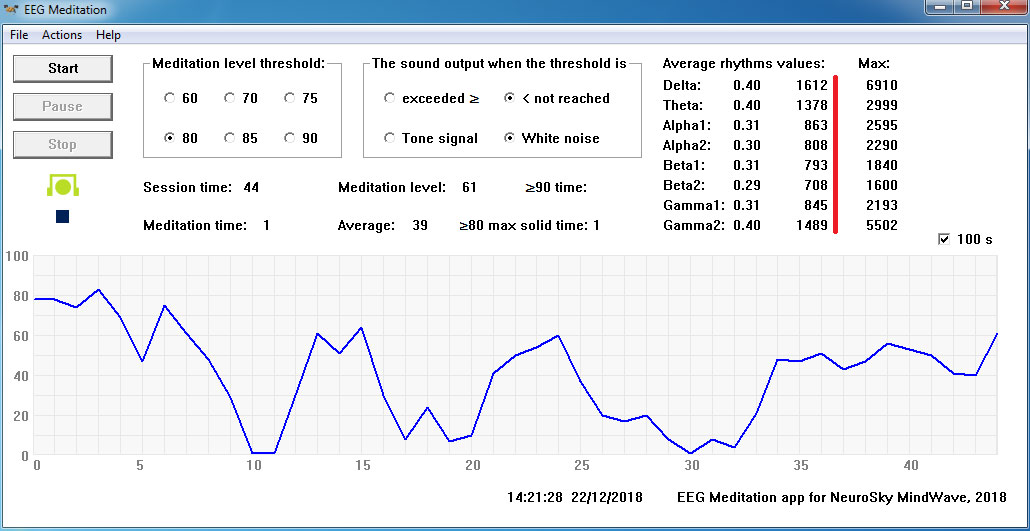
|
By the way, Cody Rall has NeuroSky MindWave Mobile headset – I saw it in his video. It would be interesting to see his screenshots (similar to these) of what he considers his good meditation with NeuroSky headset. It can be in Fred Mellender's "NeuroExperimenter" free app or in free Android "EEG Meditation" app.
Because the main thing in the neuroheadset is not the trendy appearance, not the latest version of Bluetooth (NeuroSky has had Bluetooth 4.0 since 2016, starting from "Mindvave Mobile+" version and including "Mindvave Mobile 2" version), not the scattering of Swarovski crystals over the entire surface of the neuroheadset, but accurate and reliable parameter of shamatha meditation. But to comprehend this, you need to be a meditator, and not just a video blogger.
EMOTIV is one of the many companies developing EEG interfaces. Its peculiarity is that it immediately swung to recognize a large number of individual emotional states in order to create a multi-command brain-computer interface. For this, the first device – EMOTIV EPOC, released in 2009, had 16 sensors and 14 EEG channels with a wireless radio channel for transmitting data to its own transceiver.
Due to the fact that this device was actually the first relatively mass EEG headset, it managed to form specific ideas among many people about the allegedly controversial capabilities of such devices, which also caused disappointment with speculations, that similar gadgets supposedly read myograms instead of electroencephalograms.
Since the main goal of the company, taking into account the peculiarities of its software, was to recognize a large number of various emotions, some headset users expressed the idea that the headset, in addition to EEG, actively reads myograms – electrical signals of muscle contractions, for example, of facial muscles. Moreover, the developers allegedly mentioned this in early updates on Kickstarter.
Some EMOTIV forum users even expressed seditious thoughts that the headset generally only reads myograms. And although this is not so, the focus of EMOTIV's development on recognizing a large number of emotions, of course, is not very compatible with the idea of reading pure EEG. In the most expensive set of "researcher" in the SDK, it is possible to track EEG signals on individual sensors.
Since this was one of the first (if not the very first) ready-made, relatively massive and relatively cheap gadget, it had at least one serious drawback of electroencephalographs of the past era – “wet” electrodes. This is due to the disadvantages of using old circuitry solutions for input electronic circuits of an electroencephalograph. The electrodes, of which there are as many as 16, must be removed from the packaging, moistened with a special solution, screwed into the headset, checked the signal quality and, possibly, moistened again. Here is how one of the users describes this process:
“If you follow the instructions verbatim, then my preparation for operation looked something like this:
1. I charged the device. I downloaded, installed software / drivers / SDK.
2. I wet the sensors.
3. I checked that it was well wet.
4. I screwed the sensors into the device and peeled off my fingers.
5. I checked if they had dried out, if necessary, wet it again.
6. I put it on, turned it on, checked the connection, if necessary, wet it again.
7. I realized that my sensors are generally dry and what I did before is not even soaking.
8. I soaked sensors.
After these procedures, it said that there is a contact. The long soaking procedure is explained by the fact that the material of the tabs absorbs well a lot of liquid.”
Preparation of wet electrodes for work does not contribute to the rapid start of a meditation session. This preparation will take at least a few minutes, and also requires a significant consumption of special fluid for the electrodes. A disposable alcohol wipe for injections for wiping the dry electrodes and skin is much more convenient and cheaper.
In 2013, EMOTIV launched a new improved version of the EMOTIV EPOC + headset (the old version of the headset is no longer for sale). The new version has a 9-axis inertial sensor (gyroscope, accelerometer, magnetometer), Bluetooth and an improved battery. The electrodes remained wet.
Given the larger number of sensors compared to headsets from other manufacturers, the likelihood of a headache with prolonged wearing will be higher. More resilient sensors – more places to squeeze blood vessels on the head and more likely to get a headache with prolonged wear.
If you want to receive a raw EEG, you will have to apply for a paid subscription, and for $ 30 per month you can make no more than 30 recordings of EEG sessions per month, if the duration of each session does not exceed 30 minutes. If the session time exceeds 30 minutes, then every next 30 minutes are counted as a separate session at the expense of 30 available during the month. For a subscription of $ 99 per month, you can get an unlimited number of raw EEG read sessions. Here, as to say, no comments.
The new EMOTIV Insight was released in October 2015. Dry electrodes finally appeared in it, and their number was reduced to 5 EEG electrodes + 2 reference (base) ones. The headset uses proprietary polymer sensors that are hydrophilic; they absorb moisture from the air and skin. But at the same time, users write about the difficulties of getting a high-quality headset signal: "When I see someone running on a Kickstarter video with a working device on, I giggle, because it’s hard to get 5 green bars of signal quality just sitting still. It can also be very difficult to wear EMOTIV Insight if you wear glasses." At the same time, 12 months after EMOTIV Insight went on sale, developers on their forum recommend applying a home-made solution to the electrodes to improve the signal quality: "If there is a problem with the signal quality, try applying a little liquid to the sensors, this will help improve their electrical conductivity; for this, you can prepare the solution by mixing water with 0.5-1% salt by weight and 20% glycerol." That is, “dry” electrodes are not really “dry” in reality. In 2015, when this headset appeared on sale, for 4 years a headset from NeuroSky with really "dry" electrodes was sold.
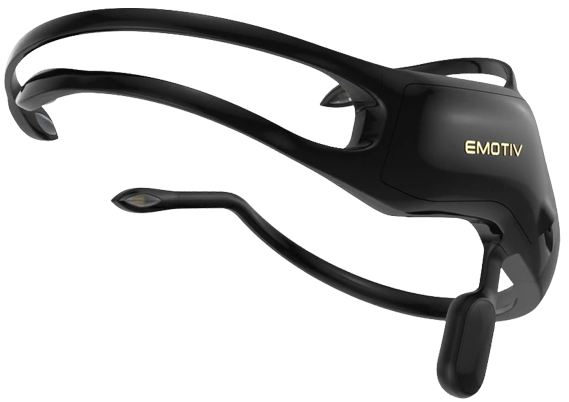 |
The device was born in agony: “And when these same people launch a campaign to create a second product, they literally go awry. The development of hardware doubled in time. Monthly updates on Kickstarter are literally the history of the f*ck ups.”
The software of the three versions of the gadgets was originally focused on the recognition of emotions. In this regard, it may not be possible to find a suitable meditation application. You will have to either be content with some application that simply shows the rhythms and the local version of the “meditation” parameter on the screen, or write your own application.
Considering the relatively high cost of the new EMOTIV Insight device at $ 299 and the lack of specialized meditation software, this is not the best option for a meditator. It is even possible that the worst (until the right software appears). EMOTIV gadgets, on the other hand, have been designed for other purposes from the very beginning.
 The Melomind headset appeared in a limited sale in late 2016. At the moment this is the most promising headset, but, apparently, is not yet the most convenient for meditators. "Melo" in the title means "melody", and this indicates its musical orientation. Currently, it is positioned primarily as a device for removing mental stress, combining soft music with biofeedback. In addition, this headset is still not available for free sale and is only available on pre-order.
The Melomind headset appeared in a limited sale in late 2016. At the moment this is the most promising headset, but, apparently, is not yet the most convenient for meditators. "Melo" in the title means "melody", and this indicates its musical orientation. Currently, it is positioned primarily as a device for removing mental stress, combining soft music with biofeedback. In addition, this headset is still not available for free sale and is only available on pre-order.
1. The number of applications is very limited. SDK is available for writing your own applications. Unfortunately, this headset remains a semi-closed "club" device, and its comparison is carried out with the help of the small reviews available on the Internet.
2. This is the most convenient device for meditation in the sitting position, not only from among the three listed, but also among the absolute majority of similar headsets. In fact, this headset is almost no different from the headphones, but still it will not be possible to lie comfortably with it on the pillow because of the two sensors on the back of the head.
3. Unfortunately, this headset remains a semi-closed "club" device, and its comparison is carried out on the basis of the few reviews available on the Internet. At the moment, there is no information about whether there are suitable applications for the actual practice of meditation, rather than the now proposed removal of mental tension under relaxing music with control of the degree of relaxation with the help of biofeedback.
4. Apparently, the sensors and electronics are designed so that you do not have to wipe skin or sensors before a meditation session. In addition, the data is read directly from the occipital area, and this arrangement of the sensors should provide the most reliable signal. All this is the largest "+" of this headset, making it promising.
5. This is the most expensive ($400) of three headsets (and one of the most expensive at all). In addition, it is still absent from the free sale in stores and is only available on pre-order. More expensive are just such headsets as the Versus Headset ($918).
6. If / when there are applications focused specifically on the meditators, and in case of a reduction in the price of the headset, it can become one of the most interesting.
As of the beginning of 2018, the most acceptable headset for meditators is the permanent leader of recent years – NeuroSky MindWave Mobile.
This is a translation into English of this article of the author of this site.
Meditation with biofeedback using the electroencephalograph gadget NeuroSky MindWave Mobile, or accelerated self-study of meditation.
Questions and Answers on NeuroSky MindWave Mobile neuroheadset in the context of meditation practice.
The free 'EEG Meditation' app for Android.
The free 'EEG Meditation' app for iOS.
The free 'EEG Meditation' app for Windows PC, for the white or black headsets.
The free Little Buddha: meditation with NeuroSky neuro-headsets app for Android.
The arguments in favor of the use of EEG headsets, such as NeuroSky MindWave Mobile, for meditation.
What meditation is and how to meditate.
Ìåäèòàöèÿ ñ èñïîëüçîâàíèåì îáðàòíîé íåéðîñâÿçè ñ ïîìîùüþ ÝÝà NeuroSky MindWave Mobile – óñêîðåííîå ñàìîñòîÿòåëüíîå èçó÷åíèå ìåäèòàöèè. Îáùèå âîïðîñû ÝÝÃ-ìåäèòàöèè.
 The NeuroSky MindWave Mobile headset is available since 2011, and at the end of 2016 an improved "MindWave Mobile+" version was released. In May 2018, a new, very wearable version "MindWave Mobile 2" was released. This is the first mass gadget to read the EEG, and at the moment, sold more than 4 million sets, which makes this headset also the absolute leader in sales among all varieties of similar (EEG) devices, including for meditation. In addition, the company also sells the "base" of the headset – the TGAM module, which provides EEG reading and its transfer via the COM port, which is used in a variety of projects.
The NeuroSky MindWave Mobile headset is available since 2011, and at the end of 2016 an improved "MindWave Mobile+" version was released. In May 2018, a new, very wearable version "MindWave Mobile 2" was released. This is the first mass gadget to read the EEG, and at the moment, sold more than 4 million sets, which makes this headset also the absolute leader in sales among all varieties of similar (EEG) devices, including for meditation. In addition, the company also sells the "base" of the headset – the TGAM module, which provides EEG reading and its transfer via the COM port, which is used in a variety of projects.
 The Muse headset appeared in May 2014. The main differences from the NeuroSky headset are the lack of an upper headband, the presence of a built-in lithium battery and 7 sensors (5 on the forehead and 2 on the head skin behind the ears) instead of 3 of NeuroSky. In fact, Muse looks like an attempt to improve the first mass similar headset (NeuroSky).
The Muse headset appeared in May 2014. The main differences from the NeuroSky headset are the lack of an upper headband, the presence of a built-in lithium battery and 7 sensors (5 on the forehead and 2 on the head skin behind the ears) instead of 3 of NeuroSky. In fact, Muse looks like an attempt to improve the first mass similar headset (NeuroSky).

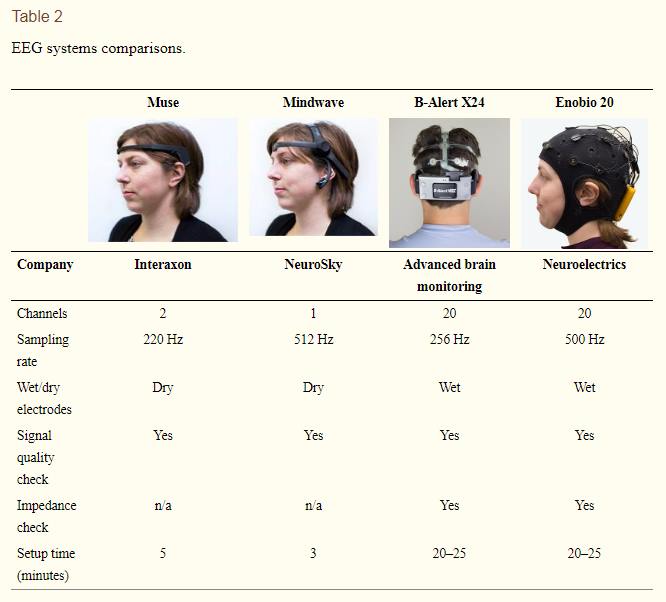
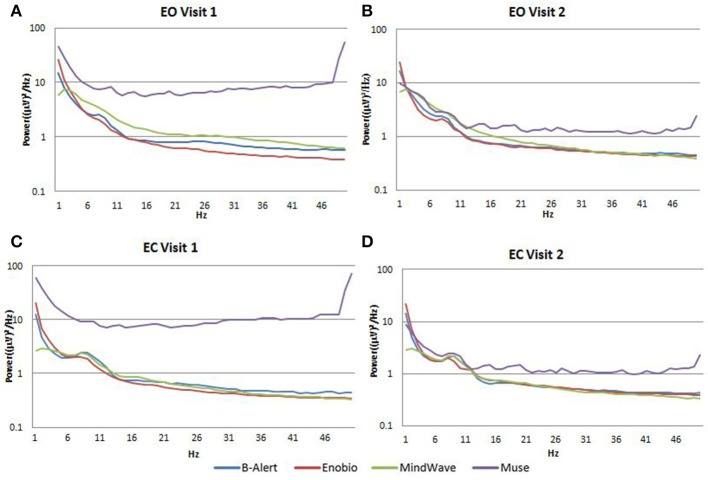
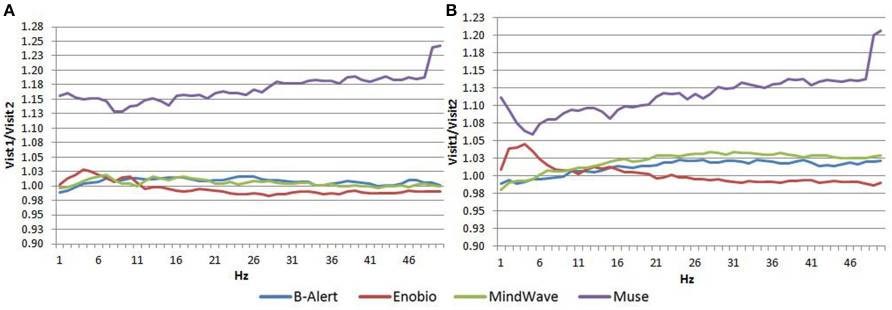

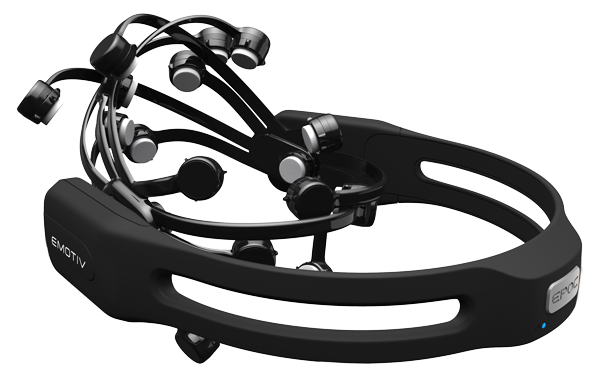

 The Melomind headset appeared in a limited sale in late 2016. At the moment this is the most promising headset, but, apparently, is not yet the most convenient for meditators. "Melo" in the title means "melody", and this indicates its musical orientation. Currently, it is positioned primarily as a device for removing mental stress, combining soft music with biofeedback. In addition, this headset is still not available for free sale and is only available on pre-order.
The Melomind headset appeared in a limited sale in late 2016. At the moment this is the most promising headset, but, apparently, is not yet the most convenient for meditators. "Melo" in the title means "melody", and this indicates its musical orientation. Currently, it is positioned primarily as a device for removing mental stress, combining soft music with biofeedback. In addition, this headset is still not available for free sale and is only available on pre-order.